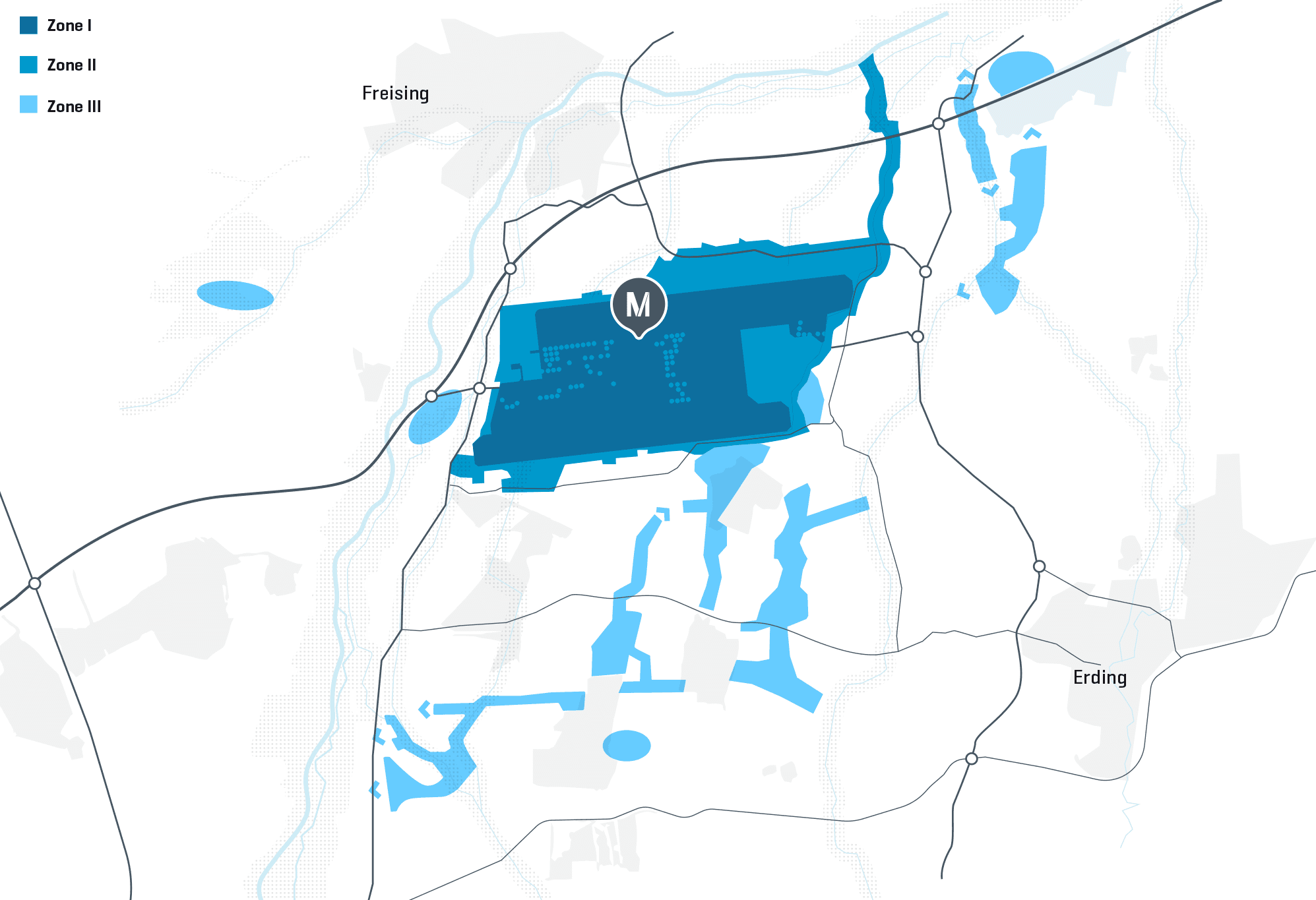Biodiversity
Three-zone concept: creating valuable habitats
To integrate Munich Airport into its environment in the best possible way, FMG created structures from the very outset that would ecologically upgrade the extensive surrounding area in the Erdinger and Freisinger Moos and link it together. For this purpose, a three-zone concept was implemented within the framework of the current green regulations: Zone I comprises the airport premises with runway system, buildings and roads, Zone II the wooded and structurally rich green belt around the airport premises and Zone III the ecological compensation measures.
Zone model


Zone I: airport premises with runway system, buildings, and roads
Green areas with currently around 5,000 planted trees make up almost two thirds of the airport grounds. Through targeted maintenance, species-rich vegetation and ecologically valuable habitats, especially for rare meadow breeders, have been created, notably within the security fence, on the green areas between the runways and their infrastructure facilities.
Zone II: woody and structurally rich green belt around the airport premises
The airport perimeter zone with its wooded areas, drainage ditches, and meadows provides noise control and buffers for residential areas and agriculture. The northern pre-flood ditch with its near-natural course is home to protected plants such as pasqueflower, ox-eye daisy, perennial, and bellflower. The list of specially protected species includes the marsh gladiolus and the variegated pondweed.
Zone III: ecological compensation measures
FMG has now planned and created around 520 hectares of compensation areas. They serve to compensate for the impact on nature and the landscape caused by construction projects. The responsible approval authorities confirmed that they were produced and maintained in accordance with the requirements. These nature conservation compensation areas contribute significantly to the region’s biodiversity with their richly structured and species-rich vegetation. They are distributed across the agricultural land and form retreats and stepping stones in the biotope network. They are neither fertilized nor treated with pesticides.
Biotopes: additional compensation areas planned
FMG has created biotopes for sand lizards at the Vorflutgraben Nord. They are used to replace the original habitats where trees had to be felled for safety reasons. In addition, the hollows built for the little ringed plover west of the airport were resealed. This migratory bird, whose natural habitat on sand and gravel banks in floodplains is becoming scarce, is now enjoying optimal conditions there. New compensation areas - primarily in Oberdingermoos - are to be created in fall 2024. Furthermore, the airport will implement compensation and replacement measures for the gray partridge on the campus in accordance with its requirements.
Bird sanctuary: a home to endangered bird species
15 years ago, in August 2008, the areas of the «Nördliches Erdinger Moos» were designated as an EU bird sanctuary. In addition to the Eurasian curlew, lapwing, and grey wagtail, a total of 40 bird species, some of which are highly endangered, enjoy a high level of protection on and around the grounds of Munich Airport. The heart of the 4,525-hectare bird sanctuary is the approximately 666-hectare airport meadows around both the take-off and landing runways. In 2023, they were home to the most important meadow breeding area in Bavaria with 99 breeding pairs of curlew and 79 breeding territories of lapwing, the bird of the year in 2024. The endangered black-tailed godwit, of which there were 19 breeding pairs across Bavaria in 2021, has also repeatedly raised young birds on the airport meadows. Furthermore, in conjunction with the compensatory and replacement areas outside the airport premises, the airport serves as a refuge for rare plant species such as the creeping celery, reptiles such as the sand lizard, and insects such as the bird’s-eye damselfly.
Development of Breeding Birds


Biodiversity: new flowering areas in the Visitors Park
In addition to the legal requirements, we also voluntarily support projects that promote biodiversity. One example of this is a wildflower meadow planted with seeds from the region on the southern viewing hill. The newly created habitat helps to maintain genetic diversity and ensures optimal interaction between plants and insects. Over time, an adapted maintenance regime allows a species-rich meadow to develop on nutrient-poor soil.